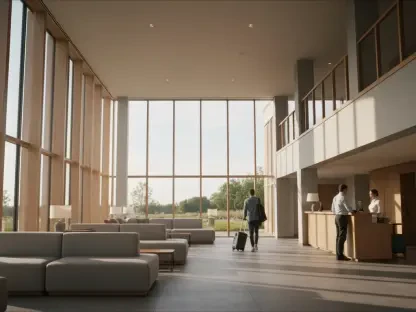Lake Tahoe, straddling the states of California and Nevada, finds itself at the intersection of two seemingly conflicting interests: thriving tourism and the demand for affordable housing. As technology-driven platforms like Airbnb and VRBO continue to flourish in this picturesque region, the area witnesses growing tensions between sustaining tourism and providing affordable housing for its residents. The rise of short-term rentals (STRs), often touted as an economic boon for localities, also risks altering the neighborhood fabric and intensifying the pressure on accessible housing. This introduces a layered challenge that weighs the economic benefits against social and housing concerns, urging an investigation into how these dynamics can be effectively managed in the Tahoe Basin.
The Influence of Short-term Rentals on Local Communities
The Evolution and Expansion of STR Platforms
The concept of short-term rentals, commonly known as vacation home rentals, has long been a staple in tourism regions. Emerging as an alternative to traditional hotels, the sector gained significant traction in the modern era with the establishment of platforms such as VRBO in 1995, later joined by giants like Airbnb. These platforms offer homeowners an avenue to monetize their properties by transiently renting them to tourists, especially appealing in sought-after locations like Lake Tahoe. This evolution transformed STRs into a commoditized segment within the lodging landscape, raising pertinent debates about their deeper impact on housing markets.
While these platforms bring convenience and economic gains, especially in regions with high tourist influx, they also present pronounced consequences for the local communities. Speculative property acquisitions have grown, driven by the prospects of lucrative short-term returns, consequently squeezing the availability of long-term rentals. Properties that could serve as homes for local families increasingly shift toward servicing temporary visitors, impacting housing supply and contributing to housing shortages. The balance between reaping monetary gains from tourism and safeguarding local residents’ access to housing is a central theme in ongoing discussions about policy and regulation.
Impact on Housing Affordability and Neighborhood Dynamics
The surge of short-term rentals across the Lake Tahoe region has had notable effects on housing affordability, creating hurdles for individuals seeking long-term accommodations. Neighborhoods, previously defined by their residential characteristics, are transforming under the weight of increased STR activity. This influx amplifies the demand for existing housing stock, resulting in a distortion of prices and making it challenging for locals to secure affordable living spaces. Many potential long-term rentals convert to short-term use, further reducing inventory availability for long-term tenants.
Moreover, the clustering phenomenon—where certain neighborhoods witness a high density of STRs—often undermines the residential atmosphere due to increased noise, traffic, and disruptions. This clustering places additional burdens on community infrastructure and negatively impacts the quality of life for permanent residents. Discontent within neighborhood circles is pronounced, as evidenced by statistics from surveys conducted in South Lake Tahoe, showcasing community apprehension over the prevailing shift towards an environment dominated by short-term lettings. Such sentiments underline the urgency for effective strategies to maintain housing affordability while preserving neighborhood integrity.
Regulatory Frameworks and Challenges in Lake Tahoe
Striking a Balance Through Local Regulations
In response to growing concerns about short-term rentals and their community implications, counties within the Lake Tahoe Basin have introduced various regulatory measures aimed at moderating STR activity. These regulations attempt to strike a resonant balance between encouraging tourism-driven economic benefits and preserving the availability of affordable housing. Various counties require permits for operating STRs and impose strict caps on their numbers relative to the total housing stock. These caps serve as mechanisms intended to control the expansion of short-term rentals, thereby preserving the local housing landscape for residents.
For instance, Placer County enforces a relatively higher cap at 32.5%, diverging from surrounding regions, while neighboring Washoe County adopts an approach emphasizing operational compliance over numerical limitations. This regulatory diversity reflects the varying philosophies and strategic intents adopted by local governments and the ongoing experimentation to identify policies that best address the complex interplay of economic interests and housing needs. The desire to preserve neighborhood character while maintaining economic vibrancy drives the continuous evolution and assessment of these regulatory frameworks.
Community Response and the Search for Solutions
The Lake Tahoe community, driven by concerns around housing availability and residential quality of life, has actively engaged with regulatory discussions, often advocating for stricter controls on STRs. Local measures like South Lake Tahoe’s Measure T—which attempted to phase out vacation rentals from residential zones—demonstrate the tensions arising from these debates. Despite its eventual judicial rejection, Measure T represented a significant community effort to curb STR proliferation, illustrating the friction between different stakeholder interests. The discourse following such proceedings highlights the persistent challenge in formulating cohesive regulations that resonate with the needs of both the tourism sector and local communities.
In addition to regulatory efforts, initiatives like the Placemate program have emerged as innovative approaches aimed at incentivizing property owners to convert non-rental homes into long-term rental options. Such initiatives symbolize a proactive strategy to counterbalance the effects of STRs, endeavoring to expand the pool of available affordable housing without completely stifling tourism activity. As stakeholders strive to navigate the nuanced dynamics, the search for cooperative solutions remains central to creating a sustainable balance between economic opportunities and housing accessibility in Lake Tahoe.
Economic Implications and Future Considerations
Tourism Revenue Versus Housing Demand
The economic discourse surrounding short-term rentals in Lake Tahoe reveals a dichotomy between deriving revenue from tourism and meeting the housing needs of locals. Advocates for STRs highlight the economic benefits derived from this tourism influx, underscoring the crucial role of the sector in bolstering local economies. Beyond direct rental income, tourism catalyzes auxiliary economic activities within the region, from retail and dining to broader hospitality services, enhancing the financial ecosystem in a way that benefits municipal coffers.
Conversely, critics maintain that the shortcomings of STRs are profound and multifaceted, with the shortage of affordable housing aggravating social inequality and stressing community infrastructures. Long-term residents face significant housing pressures, necessitating dialogue around strategies to reinvest STR-generated revenues into projects aimed at alleviating the housing crisis. Directing portions of STR-related fees toward the development of affordable housing projects represents one potential policy pathway that aims to creatively merge economic and social objectives.
Long-term Strategy for Lake Tahoe’s Housing Market
Lake Tahoe, situated between California and Nevada, grapples with clashing priorities: the flourishing tourism industry and the urgent need for affordable housing. This popular destination is seeing the impact of tech-driven platforms such as Airbnb and VRBO, which are thriving in its breathtaking surroundings. Consequently, there’s rising friction between the push to sustain tourism and the necessity to supply affordable housing to the community. Short-term rentals (STRs) are marketed as economic engines for local economies, yet they pose the risk of transforming neighborhoods and exacerbating the already strained affordable housing situation. This scenario presents a complex challenge: balancing the economic perks of tourism with the pressing social and residential needs within the Tahoe Basin. Thus, it calls for a thorough examination of how these competing interests can be effectively managed, ensuring that economic growth does not overshadow the fundamental housing requirements of residents. Solutions must be devised that strike harmony between these opposing needs, so that the area’s social fabric and economic vitality remain intact for future generations.









